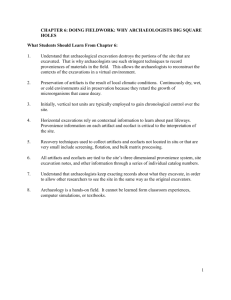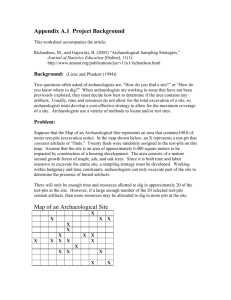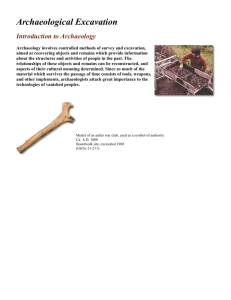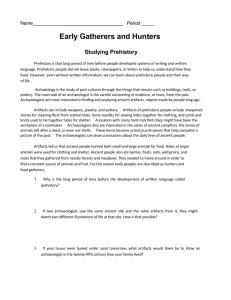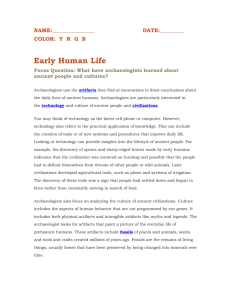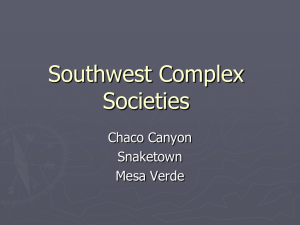The Big 6 - Dig it
advertisement
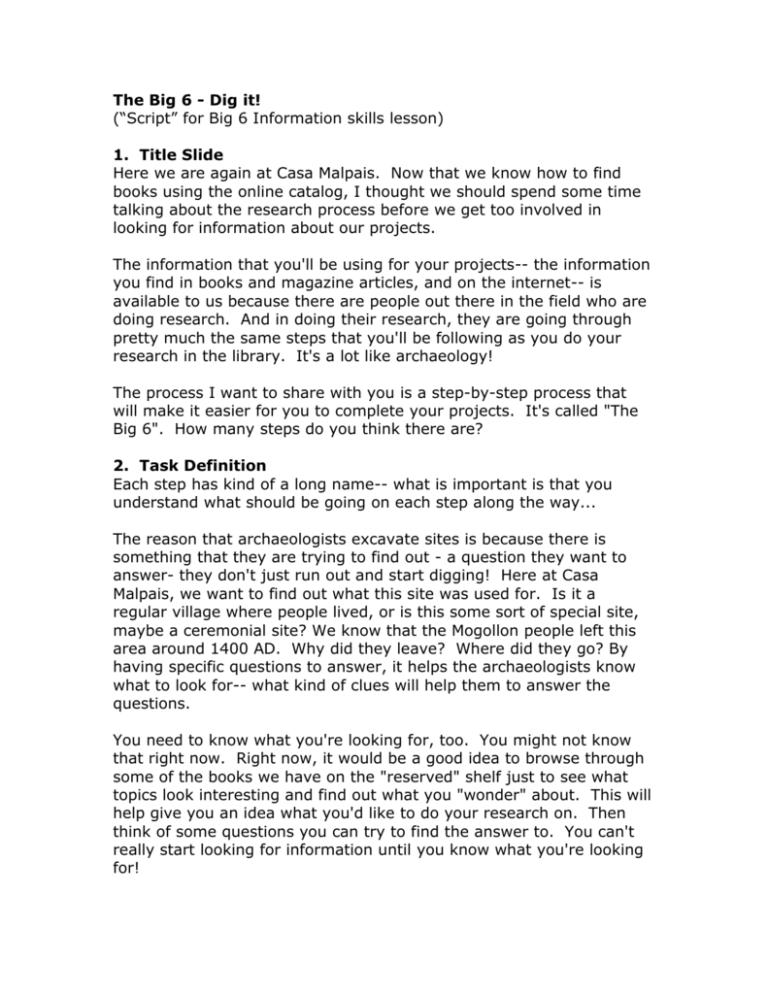
The Big 6 - Dig it! (“Script” for Big 6 Information skills lesson) 1. Title Slide Here we are again at Casa Malpais. Now that we know how to find books using the online catalog, I thought we should spend some time talking about the research process before we get too involved in looking for information about our projects. The information that you'll be using for your projects-- the information you find in books and magazine articles, and on the internet-- is available to us because there are people out there in the field who are doing research. And in doing their research, they are going through pretty much the same steps that you'll be following as you do your research in the library. It's a lot like archaeology! The process I want to share with you is a step-by-step process that will make it easier for you to complete your projects. It's called "The Big 6". How many steps do you think there are? 2. Task Definition Each step has kind of a long name-- what is important is that you understand what should be going on each step along the way... The reason that archaeologists excavate sites is because there is something that they are trying to find out - a question they want to answer- they don't just run out and start digging! Here at Casa Malpais, we want to find out what this site was used for. Is it a regular village where people lived, or is this some sort of special site, maybe a ceremonial site? We know that the Mogollon people left this area around 1400 AD. Why did they leave? Where did they go? By having specific questions to answer, it helps the archaeologists know what to look for-- what kind of clues will help them to answer the questions. You need to know what you're looking for, too. You might not know that right now. Right now, it would be a good idea to browse through some of the books we have on the "reserved" shelf just to see what topics look interesting and find out what you "wonder" about. This will help give you an idea what you'd like to do your research on. Then think of some questions you can try to find the answer to. You can't really start looking for information until you know what you're looking for! Once you have a question in mind, think about what might help you answer the question. If you want to know what the homes of the Mogollon looked like, then you'd probably really like to see a picture-you'd be looking for a book that had pictures in it. If you want to know where else did the Mogollon people live besides Casa Malpais, you might like to find a map showing different places they lived. If you're interested in food, you might want to find a resource that includes recipes. If you want to make a pot, you probably want to find a resource that includes instructions, instead of one that talks about what pots were used for. Once you've thought about these things-- and step #1 is really pretty much a "thinking" step, then you're ready to go on to step #2. 3. Information Seeking Strategy Okay, archaeologists-- you have a question you want to answer. Where do you begin to look. Casa Malpais covers 14 1/2 acres on top of a ridge. Where should you dig? Where would you be most likely to find artifacts that will help answer your question? Well, archaeologists use what they already know to figure out where to look. Places that face south are good places to look-- it would be warm there in the winter-- a good place to live. Places near water are good places to look. Places near where rock art is found are good places. And they look for patterns. By looking at the rocks here, we can tell that there are unexcavated rooms here-- this would be a good place to start. We can probably find some artifacts here to help answer our questions. Where can you look for facts to help answer your questions? What resources do you have available in the media center (books, magazines, cd-roms, internet...). Can you think of any other resources (people are resources too). Once you've thought of all the possibilities, decide where would be the BEST place to look-- you may as well start at the top! For instance, if you are research prehistoric indians, where do you think you'd be more likely to find the most information: books or magazine articles? Why? What kind of information do we usually look for in magazines? 4. Location and Access Once the archaeologist has decided WHERE to begin looking, how do they get to the information they need? What kind of tools do they use? (trowels, brushes, dustpans, buckets, screens...). Their information is BURIED, so they have to dig to get at it. Say you've decided that the best place for you to begin looking is in a book. What tool do you use to find the book? (OPAC). Okay, here's the book, but the information you want is BURIED somewhere in this book-- what tools are you going to use to get to it? (Table of contents, index, headings...). What if your information source is a person? Once you've LOCATED the person, how are you going to ACCESS their information? (interview questions). 5. Use of Information As the archaeologists are digging for their information, they remove lots of DIRT along with the artifacts they're looking for. All that dirt needs to be sifted to make sure some tiny little artifacts isn't being overlooked. The people sifting the dirt have to go through the screen very carefully to separate the stones from the pottery sherds and projectile points, and beads-- artifacts that might hold important information for the archaeologists. As you read the information you've located, or view, or listen to the information in the sources you've selected, you will have to sift through it and separate the facts you can use from the ones that aren't relevant. Remember that some of the topics you're working on are ones where you're not going to find TONS of information-- so any little bits or facts that you find will be important. Remember how excited the people in the video were over finding the "white bead"-- it was a tiny little thing that could have been overlooked. Anything you find that helps you answer your question (from step #1) is important! 6. "When you find something important, keep track of where you got it!" And when you do find something important, it's important to keep track of where you found it. In the video you saw how, when the pot was found, we measured how deep in the ground it was; we made a little sign and took pictures of it-- because it's important to know where it came from-- that's part of the information you need to collect. A good archaeologist would never just figure, "oh well, I'll remember where I got it"-- and you shouldn't either. Collect that information for your bibliography! 7. Synthesis Synthesis is fitting together all the pieces. The artifacts that the archaeologist removes from a site have to be organized, and studied, and put in some kind of order so that something can be learned from them. You've collected information from several different sources and now you have to fit that information together in order to answer the question you had back in step #1 (what was that step called?). Remember how the archaeologists had separate bags for each kind of artifact, and each bag was labelled-- well you'll probably need to get your facts organized too, to make it easier to do something with them. You might want to make an outline, and fill your facts in in the appropriate categories. Or you might use a graphic organizer-- or make lists. 8. "how do you want to present your information?" So now that you've got all these well organized facts, what are you going to do with them? How are you going to share what you've learned with other people? How are you going to present that information? Are you going to make something? Build a model? Draw a picture? Tell a story? Write a report? Decide what's the best way to communicate what you've learned and do it! The "best" way will probably depend on what your question was. If you were an archaeologist studying pottery, well the best way to present your information would probably to be to glue all the pottery sherds together and show what the pot looked like! 9. "Tell where each bit of information came from in your bibliography" And part of your presentation is letting people know where your information came from. If we were archaeologists, we would be sitting in a lab painting nail polish on pot sherds and writing tiny little numbers on them. Then, later on, if someone wanted to study what we found, they would have the information they needed to help them learn more. Well, that's what your bibliography is. When someone reads your project on the internet, and is fascinated by what you found out, they can use your bibliography to go back to the sources you used so they can learn even more about your topic! And it adds value to your work, because people will know exactly where you found your information-- that makes YOU a credible source-- someone they can trust and believe. 10. Evaluation Once we've done all that, there's nothing left to do but sit back, admire our work, and think about how we did. Did we find what we were looking for? What did you do well? What might you do differently next time. For instance, if you spent a lot of time looking for things on the internet and didn't find much, but you found a lot of really great information in books-- what would you do the next time you had research to do? If you got some of your information from watching a videotape, and seeing the pictures really helped you to understand the topic better than if you just read about it, you might decide that the next time you have research to do, you might look for a video first-- because it would make it easier for you to understand what you read about the topic later. It's always a good idea to evaluate at the end of a project because that way we can be faster, better researchers next time. 11. The Big Six So here's our six steps. Steps one, two and six are "thinking" steps-so, hey, you're only working half the time! Review steps. 12-17. Review of steps 18. The end! 19. Credit Shayne Russell Library Media Specialist Mt. Laurel Hartford School Mt. Laurel, NJ

